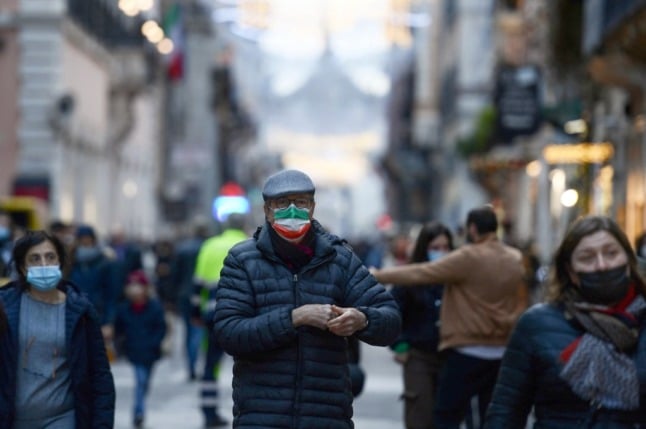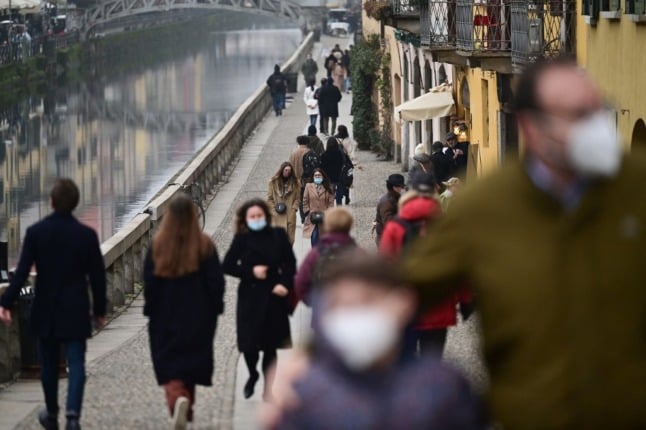Italy set a new record on Tuesday with 220,532 new Covid infections in the last 24 hours, according to data from the health ministry.
Some regions are faring worse than others – the figures for Piedmont, Calabria, Liguria and Sicily show an increasing amount of Covid hospital admissions, both in general occupancy and in intensive care.
Based on these parameters, the first two of these regions have already exceeded the threshold for entering an ‘orange’ zone.
To be moved into this higher restricted tier, a region or autonomous province must record a Covid incidence rate of 150 cases per 100,000 inhabitants, combined with 20 percent ICU and 30 percent general ward Covid patient occupancy.
In Piedmont, the latest data has recorded 24 percent ICU occupancy and 33 percent for general admissions, according to figures from Agenas, Italy’s National Agency for Health Services. The incidence rate in this region has also already far exceeded the threshold for this week at 635.75.
MAP: The Italian regions becoming Covid ‘orange’ zones in January
Meanwhile in Calabria, ICU occupancy has now met the threshold at 20 percent and its ordinary admissions have surpassed it at 38 percent. Its incidence rate has also exceeded the maximum limit to stay in a lower risk ‘yellow’ zone at 204.50.
Liguria and Sicily, on the other hand, are looking very close to outstripping the parameters in time for the national data review on Friday. Italy’s health ministry examines the latest figures each week and decides which restrictions should be applied to a region or autonomous province from the following Monday.
Liguria hangs in the balance with 38 percent rate of hospitalisation in ordinary wards, but intensive care has been stable for several days at 20 percent. In theory, it has met the criteria to move into an ‘orange’ zone, but there are still a couple of more days to gauge whether its ICU occupancy fluctuates. Its incidence rate has already far surpassed the threshold at 755.42.

The numbers are constantly growing in Sicily and this region could also face tighter health measures from Monday. As of Wednesday, its ICU occupancy is 20 percent, while general admissions are 32 percent. Its incidence rate is 435.15.
For these regions, it looks likely that they’ll lose their ‘yellow’ zone status – but it’s not a given.
The government has discretionary powers to move a region into a new zone even if the thresholds aren’t exceeded. Likewise, an area could remain in a lower restricted zone when they have – the figures serve as a guide for the health authorities.
Other regions are at risk of moving into an ‘orange’ zone in the coming weeks, based on their health data.
Friuli-Venezia Giulia, Marche, the autonomous province of Trento and Valle d’Aosta have all shown increasing numbers admitted to their hospitals, in both ICU and general occupancy this week.
If an area becomes an ‘orange’ zone, vaccinated people won’t experience much of a change, as most venues and activities will remain open and accessible to those with Italy’s ‘super green pass’ health certificate that shows the bearer is vaccinated against or recovered from Covid.
EXPLAINED: What are the rules in Italy’s Covid ‘orange’ zones?
There are presently 15 regions in the yellow zone and six regions are still in the lowest-risk ‘white’ zone – but some of those in the lowest restricted tier could lose that status and soon move up into a ‘yellow’ zone.
To enter a ‘yellow’ zone, any region above the threshold of 10 percent ICU and 15 percent general ward Covid patient occupancy and with a new weekly incident rate of 50 cases per 100,000 inhabitants should automatically be moved into this tier.
Campania now has yellow-zone data with 12 percent intensive care occupancy and 25 percent admissions in non-critical areas. Umbria too has already met the criteria for a ‘yellow’ zone with 16 percent ICU admissions and 30 percent for ordinary wards.
The health situation is worsening in Puglia with 10 percent ICU admissions and 17 percent for ordinary admissions, while in Sardinia ICU admissions are 14 percent and general wards are 13 percent.
The incidence rate for all these regions has already far exceeded the threshold for this parameter.
The only two regions not at risk of losing their ‘white’ zone status at the moment are Basilicata and Molise.
Anti-contagion measures in both ‘white’ and ‘yellow’ zones are similar – until January 31st at least, mask-wearing outdoors is mandatory even in the ‘white’ zone.
Note that local authorities in Italy can also decide to impose stricter rules at short notice. Always check the latest restrictions in your province or town: find out how here.
For further details about Italy’s current Covid-19 health measures please see the Italian Health Ministry’s website (available in English).



 Please whitelist us to continue reading.
Please whitelist us to continue reading.
The whole system needs scrapping